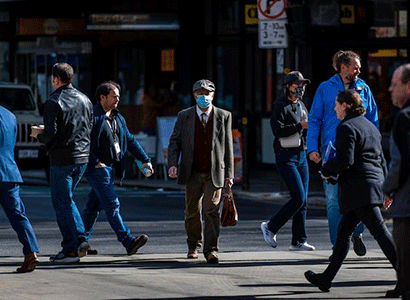 |
| Each COVID-19 wave has been smaller than the one before and that trend is set to continue. Photo ABC |
Australia’s fifth COVID-19 wave is approaching
(ABC) -- A leading epidemiologist says it is clear Australia is approaching its fifth wave of COVID-19.
University of South Australia Professor Adrian Esterman says it is certainly true for South Australia, which has seen cases increase for three consecutive weeks.
But, how is the rest of the nation tracking and what could a fifth COVID wave look like?
Simply put, a wave happens when the numbers increase week on week.
Infectious diseases paediatrician Robert Booy says it doesn’t depend on how many cases there are, but rather that there is a surge in numbers.
“It’s about what was the rate of disease this week compared to last week and the week before,” he said.
The number of average daily cases has increased by 19.7 percent across the country in a week.
This is based on data from May 16 and relies on people recording their positive COVID test results.
This data shows that the number of average daily cases rose in each state and territory apart from the Northern Territory.
However, how each jurisdiction is reporting its COVID cases is starting to change.
For example, Queensland is now reporting its seven-day rolling average rather than the number of COVID cases reported each week.
This will be the fifth wave in 18 months in Australia.
Each one has been smaller than its predecessor and Professor Booy expects this trend to continue.
“We have immunity both from vaccination and from prior disease, which means that the majority of people, if they get infection at all, will get it only mild to moderately and not severely,” he said.
He says three years into the pandemic, the virus is running out of ways to mutate and to evade our immunity.
“It’s finding occasional subtle ways to be different, but not to the extent where it’s likely to cause a major outbreak,” Professor Booy said.
Each infectious disease affects people differently based on their age and where they live.
Professor Booy says it is difficult to predict how it will impact people.
Despite this, he says colder places where people spend more time indoors and crowd together with limited ventilation are more likely to be affected than regional areas where you seldom have contact with other people.
University of New South Wales Professor James Wood said he was not expecting the wave to persist throughout winter.
“We are expecting a peak in cases in June,” he said.
He believes NSW is at the peak of its current wave, which has been influenced by the cooler weather.
He says there appeared to be a rise in transmission after students returned for term two.
Professor Wood says this could be related to the colder weather and being back in the classroom and transmission in those spaces.
When the fourth wave finished in February, after the arrival of the Omicron variant, it was the longest to date at 19 weeks. But according to the Department of Health, it wasn’t as severe as the wave during winter last year, with lower hospital and intensive care admissions.
There were also fewer deaths than during other waves.
For the first time since the start of the pandemic back in 2020, there were virtually no public health or social measures in place for the fourth wave.
Deputy Chief Medical Officer Paul Kelly said this was a testament to the high levels of vaccination coverage, hybrid immunity and having oral antiviral treatments accessible to those who needed them.
In reflecting on the fourth wave, Professor Kelly advised that it was important that response measures were “appropriate and proportionate” to the level of risk. He said there needed to be a focus on improving health outcomes among those at greater risk of severe illness.
Australian health department data shows 2.5 million booster doses have been administered by state providers across the country so far this year.
The Australian Technical Advisory Group on Immunisation (ATAGI) recommends a 2023 vaccine booster dose for adults if it has been six months or longer since their last COVID-19 booster or confirmed infection.
It is particularly recommended for:
- Everyone 65 years and over
- Everyone 18 years and over with medical comorbidities, disability or complex health needs
ATAGI advises a 2023 booster dose should be considered by:
- All adults aged 18-64 years without risk factors for severe COVID-19
- Children from five to 17 years old who have medical comorbidities that increase their risk of severe COVID-19
A booster dose is not recommended by ATAGI at this time for children under the age of 18 who do not have any risk factors for severe COVID-19.
(Latest Update May 24, 2023)
|